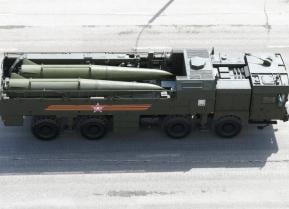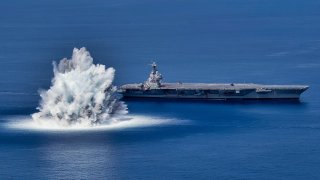Should Donald Trump Risk the U.S. Navy in a War Against China?
As the U.S. Navy faces potential conflict with China in the Pacific, leaders must decide when to risk their valuable, hard-to-replace capital ships, such as Ford-class carriers, in battle. In a potential Taiwan conflict, China would likely commit extensive forces, while the U.S. might hesitate due to public opinion and fleet dispersion.
U.S. military lingo awkwardly dubs nontraditional implements of sea power “riskworthy.” They are the opposite of lumpy capital. Some—uncrewed vehicles in particular—are altogether expendable. In short, commanders can take a venturesome attitude toward platforms that are plentiful and inexpensive by contrast with high-tech destroyers or lumbering, scarce, über-capital-intensive flattops. Sea denial lets maritime overseers delay risking the capital-ship fleet until a more favorable correlation of forces beckons. Once U.S. naval and joint forces have gathered in the theater and outmatch the foe, then commanders may opt to launch into an offensive culminating in a—yes, risky, no escaping it—decisive Mahanian engagement.
In short, senior leaders can conserve lumpy capital through sea denial—expending lesser assets as an interim measure pending more auspicious times.
Embrace “calculated risk” at the operational level. Depending on how their sea-denial strategy unspools, U.S. commanders may ultimately bid for maritime supremacy in the Western Pacific. Enfeebling the PLA Navy would solve many problems. They are far from the first to face the quandary of whether to risk the fleet. On the eve of the Battle of Midway in mid-1942, Admiral Nimitz instructed task-force commanders Rear Admiral Raymond J. Spruance and Rear Admiral Frank Jack Fletcher to engage the Imperial Japanese Navy’s Kidō Butai, or mobile aircraft-carrier striking force, based on the “principle of calculated risk.” In effect Admiral Nimitz told Spruance and Fletcher to attack if they expected to do worse to the Japanese fleet than the Japanese fleet would do to them.
U.S. commanders appraising the People’s Liberation Army should undertake calculations similar to Nimitz’s. If they expect to get worse than they give, they should refrain from risking the fleet. If they expect to give worse than they get, they should act. They should also bear in mind the sage but caustic words of another World War II sailor, Rear Admiral Daniel Gallery, who reputedly wisecracked that “the definition of a calculated risk is a gamble which military men take when they can’t figure out what else to do and which turns out to be right. When it turns out wrong, it wasn’t a calculated risk at all. It was a piece of utter stupidity.” Gallery's words should temper any impulse at derring-do.

Commanders should strike the golden mean between foolhardiness, meaning an excess of risk-taking, and timidity, meaning excessive aversion to risk, when debating how to deploy precious assets.
The best strategic offense is a good tactical defense. A final consideration is tactical in nature. If the U.S. Navy can defend its capital ships effectively, carrier groups in particular, then commanders can afford to strike a daring attitude vis-à-vis the foe. If not, they should exercise restraint. Navy weapons tactics specialists seem remarkably comfortable with the sea service’s ability to protect itself against antiship missiles and drones. The campaign against the Houthis in the Red Sea has been indecisive in the strategic sense, falling short of its goal of restoring merchant traffic through that swathe of the nautical common. But it has been a resounding success in the tactical sense. No warship has absorbed a hit in almost a year of warfare. Moreover, new defensive weaponry—not just extended-range precision munitions but directed energy, more robust electronic warfare, counter-drone drones, and so forth—is making its way out to the fleet. Things are looking up.
Newfangled weaponeering could hold down the risk to the fleet—making the decision whether to hazard lumpy capital more palatable. Commanders can take a more offensive stance if they repose confidence in the fleet’s ability to withstand punishment.
Naval commanders have an unenviable lot in the Pacific. They have to prevail with the force they have against a more numerous antagonist that’s able to rebound after taking heavy blows. But if they harness the assets at their command cleverly, they might yet face down or defeat aggression.
About the Author: Dr. James Holmes, U.S. Naval War College.
James Holmes is J. C. Wylie Chair of Maritime Strategy at the Naval War College and a Distinguished Fellow at the Brute Krulak Center for Innovation & Future Warfare, Marine Corps University. The views voiced here are his alone.


